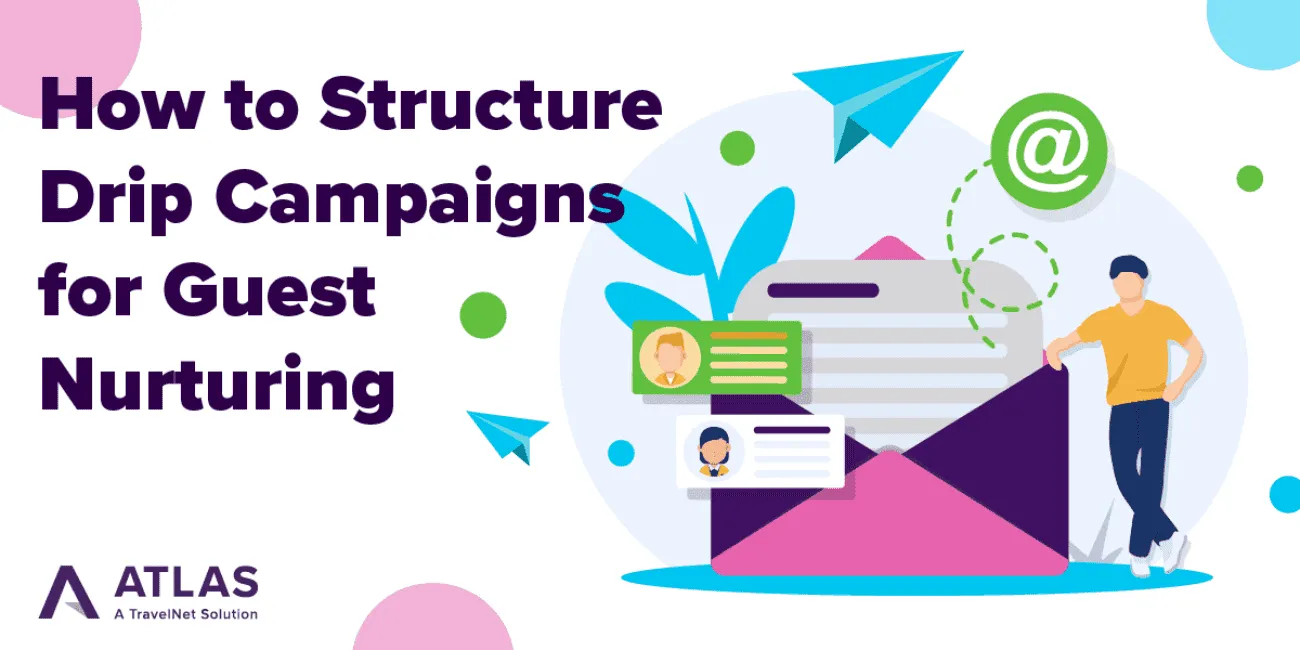How to Structure Drip Campaigns for Guest Nurturing

Property managers and hoteliers alike strive to achieve that homey, mi-casa-es-su-casa feeling that nurtures your relationship with guests and keeps them coming back.
But how can the warm and welcoming atmosphere you work to create during the stay follow them out the door? When it comes to digital marketing, there’s no better (or cost-effective) way to build loyalty and trust in your hospitality brand than through “drip” campaigns.
What’s a drip campaign?
A drip campaign is an intentional, thoughtful series of emails that roll out over a period of time. They can be time- or trigger-based, but usually they’re a combination of the two. In a sense, time-based emails are also trigger-based, as the “trigger” is the detection of a particular date and time or an interval between dates, e.g. one week prior to arrival or three days after check-out.
Time-based emails are informed by the guest journey. They can be released in advance of a stay and afterward on intervals that make sense for the guest while not being annoying or obtrusive.
For our purposes, we’ll define “trigger-based” as being triggered by a guest action. Virtually any digital interaction with your brand can trigger one or more automated actions, such as opening an email, checking in via an app, or posting a review. If you don’t have smooth integrations, you can still do this with third-party tools — more on that below.
Drip campaigns are a time-tested way to create TOMA, or top-of-mind awareness, and of course, loyalty. More importantly, they make the guest feel seen and appreciated. Combined with personalized messaging, a well-executed drip campaign can do a lot of heavy lifting.
Time-based emails
The aim of time-based emails is to anticipate what a guest is thinking or wondering about, when they’re thinking about it, and to deliver that information in a way that feels almost prescient. This comes from a deep understanding of the guest journey in general, and your guests’ journey in particular.
Pre- and immediately post-arrival
What is on a guest’s mind between the time they book and the time they arrive? What are they worried about?
Thinking through these questions helps structure the flow of your time-based emails. Here are just a few questions a good campaign can help answer or clarify:
- Is my reservation 100% confirmed?
- What is there to do in the area?
- Are there good restaurants nearby?
- Is there any kind of shuttle service?
- What were those amenities again?
Don’t assume the guest will remember this information from your listing or website. Often at booking, they just want to know they’ll have a place to crash and will work out the details later. A pre-arrival drip campaign can save them the trouble.
1–2 weeks out
At this point, the trip is probably in the deep background of the guest’s mind. They’re still dealing with life and anticipating the upcoming journey (but not necessarily looking forward to it, which we’ll cover in a moment). This is a great time to remind them of the concrete details of their trip and high-level considerations such as:
- Confirmed booking dates
- Check in/check out times
- Upcoming events
- Road closures, construction, etc.
- Anticipation of their visit
2–3 days out
This is a good time to provide information that will enrich their visit, such as:
- Nearby restaurants and attractions
- Parking information (be very specific)
- Check-in information (times, procedure, late departure, etc.)
- Relevant amenities related to arrival (e.g. bell service, concierge, valet)
- Suggested routes, road closure updates
As before, keep it short and practical. The important thing is to know what’s on their mind as they prepare to leave and address some typical concerns right then.
Post-departure
This is really where the nurturing happens. So much modern life is transactional in nature, but hospitality shouldn’t feel like that. Well-timed messages of appreciation and hospitality are a no-brainer way to surprise and delight your guests.
If you’re a Track customer, you also have the ability to send a quick thank-you text message shortly after check-out, possibly with a link to a short survey, e.g. “Did you enjoy your stay? yes/no.”
The following day
Consider an email the day after check-out once the guest has had time to travel and decompress. Thank them once again for their business, express a sincere hope that they enjoyed their stay, and invite them to complete a survey or otherwise provide feedback directly to you. We generally don’t recommend asking for a third-party review in the same email because two calls to action in one email dilutes the conversion rate.
2–3 days after check-out
This is where you should ask for a rating or review using the platform of your choice. Often, this will be the platform they used to book, but the OTAs will usually send their own drip emails asking for the same thing. That’s why we recommend pointing them to a platform like TripAdvisor or Google.
The Atlas team can help you understand which review sites drive the most business so you can encourage more reviews there.
TOMA emails
TOMA emails remind guests that you exist and that you’re thinking of them. For example, if you happen to collect their date of birth, you can send a Happy Birthday email automatically, perhaps with an enticement as a gift, e.g. 10% off or a special package.
Another great trigger is a stay anniversary. For example, if the guest was there in early July last year and you tend to fill up by May, consider sending an email in mid April encouraging them to book soon, perhaps even tied to the availability of the room type or property they booked last time.
Trigger-based emails
These are emails triggered by a specific guest action. For example, OTAs automatically send confirmation emails to go out the moment the guest books. The more integrations your PMS offers, the easier it is to set up these triggers.
Some of the most useful triggers are check-in and check-out actions, especially where a mobile phone is involved. For example, a short and sweet welcome email (or SMS text message) that invites them to complete an arrival survey or instructs them who to contact with problems. If your message contains emails and phone numbers, make sure they are hyperlinks.
Track PMS can trigger a post-arrival message with a guest action such as using an app or door code to check in. In any event, we strongly recommend using SMS text messages for the post-arrival message because it’s more immediate and can be read and responded to quickly.
This is where automations come in very handy. Not only can they be customized for your particular setup, but they’re a great way to deliver personalized service without requiring any manual work or reminders.
Campaign design and structure
The best way to visualize and plan your drip campaigns is with a flowchart. Every branch represents an if/then trigger of some kind and a short description of the message. This is a very useful tool, especially as your campaign structure becomes more sophisticated.
Workflow tools
There are many options out there for workflow planning. Some email platforms, like MailerLite, have the flowchart built right into the automation setup. Nintex and KiSSFLOW are just a few of the paid options available.
If adding yet another paid service to your tech stack makes you queasy, free options such as Pneumatic and Lucidchart are a good bet. You’ll be restricted on the number of templates or users, but for sketching out a drip campaign, they may be all you need.
PowerPoint and Google Slides support flowcharts as well, but they’re designed for presentations more than planning. A spreadsheet can work as well if that’s where you’re comfortable. Of course, there’s nothing wrong with just grabbing a notebook and sketching out how your campaign might look.
The buildout
Once you’ve plotted out your campaign, you need to build the emails and triggers. Most any paid email marketing platform will include this kind of functionality. Chances are, your PMS already integrates with one or more of them. If not, you may need to use a service like Zapier to make it happen. Most modern, cloud-based platforms make it relatively easy, but not as easy as it would be with Track’s integrated CRM and PMS.
Drip campaigns are mostly substance over style. Earlier, we alluded to the fact that not every booking is a vacation. Some guests are in town for a funeral or visiting a sick relative, so resist the urge to say things like, “Get stoked, Adam! The beach is calling your name!” Don’t make assumptions about the nature of their stay. That said, you can and should keep things in your unique voice, and conversational is better than formal.
The final step is to thoroughly test your workflow. This can be time-consuming, especially when it comes to trigger-based emails. You’ll probably want to create a “dummy” guest record to ensure things happen when and how you want. Of course, you don’t have to test in real time. Testing time-based emails, for example, can substitute two days for two weeks — just don’t forget to change the times before your workflow goes live.
How many is too many?
A good drip campaign comprises a series of light touches that don’t feel obtrusive. In other words, less is often more. But too few and far between isn’t ideal, either.
Being sensitive to guest needs means also being sensitive to their time constraints. And remember, a drip campaign is separate from other campaigns you might be sending to that same guest. Keep it simple at first and pay attention to your open, click, and unsubscribe rates. The data will tell you if you’re on the right track.
In summary
Planning, producing, and testing a drip campaign can be a bit tedious on the front end, but once your integrations and triggers are firing properly, the workflow tirelessly does the rest 24/7. The key is to know your guests’ booking journey and demonstrate that knowledge through your campaigns. Done well, drip campaigns can help turn casual guests into repeat ones and build the loyalty you crave.



